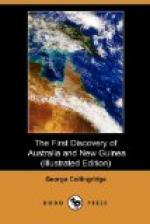The front of the bay, which is to the S., is 3 leagues long, and forms a beach. In the middle there is a river which was judged to be the size of the Guadalquivir at Seville. At its mouth the depth is 2 and more fathoms; so that boats, and even frigates could enter. It received the name of the ‘Jordan.’ On its right is seen the Southern Cross in the heavens, which makes the spot noteworthy.
To the eastward, at the corner of this bay, there is another moderate-sized river called ‘Salvador,’ into which the boats entered at their pleasure to get water.
The waters of both rivers are sweet, pleasant, and fresh. The one is distant from the other a league and a half, consisting of a beach of black gravel, with small heavy stones, excellent for ballast for a ship.
Between the said two rivers is the port. The bottom is clean, consisting of black sand, and here a great number of Ships would have room up to 401/2 brazos.
It is not known whether there are worms.*
[* Teredo Navalis.]
As the beach is not bare nor driven up, and the herbs are green near the water, it was assumed that it was not beaten by the seas; and as the trees are straight and their branches unbroken, it was judged that there were no great storms. The port was named ‘Vera Cruz,’ because we anchored there on that day.
In the whole bay we did not see a bank, rock, or reef; but it is so deep that there is no anchorage except at the above port. It is better to approach near the river Salvador, and there is another moderate port which is distant 2 leagues from this on the N. to S. coast.
All the said beach is bordered by a dense mass of great trees, with paths leading from them to the shore. It seemed to serve as a wall, the better to carry on defensive or offensive operations against other natives coming to make war. All the rest is a level plain, with hills on either side. Those on the W. side run southward, becoming more elevated and more massive as their distances increase. As for the plain, we have not seen where it ends. The earth is black, rich, and in large particles. It is cleared of wild trees to make room for fruit trees, crops, and gardens surrounded by railings. There are many houses scattered about, and whenever a view could be obtained, many fires and columns of smoke were discerned, witnesses of a large population.
The natives generally seen here are corpulent, not quite black nor mulatto. Their hair is frizzled. They have good eyes. They cover their parts with certain cloths they weave. They are clean, fond of festivities and dancing to the sound of flute and drums made of a hollow piece of wood. They use shells also for musical instruments, and in their dances make great shouting at the advances, balances, and retreats. They were not known to use the herb.*
[* Betel.]
Their arms are heavy wooden clubs, and bows of the same, arrows of reed with wooden points, hardened in the fire, darts with pieces of bone enclosed.




